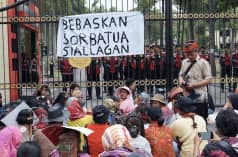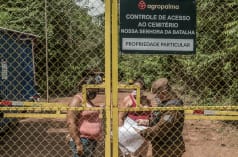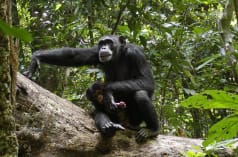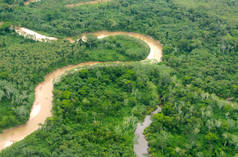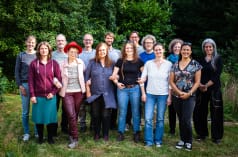Biofuel land grabbing in Northern Ghana
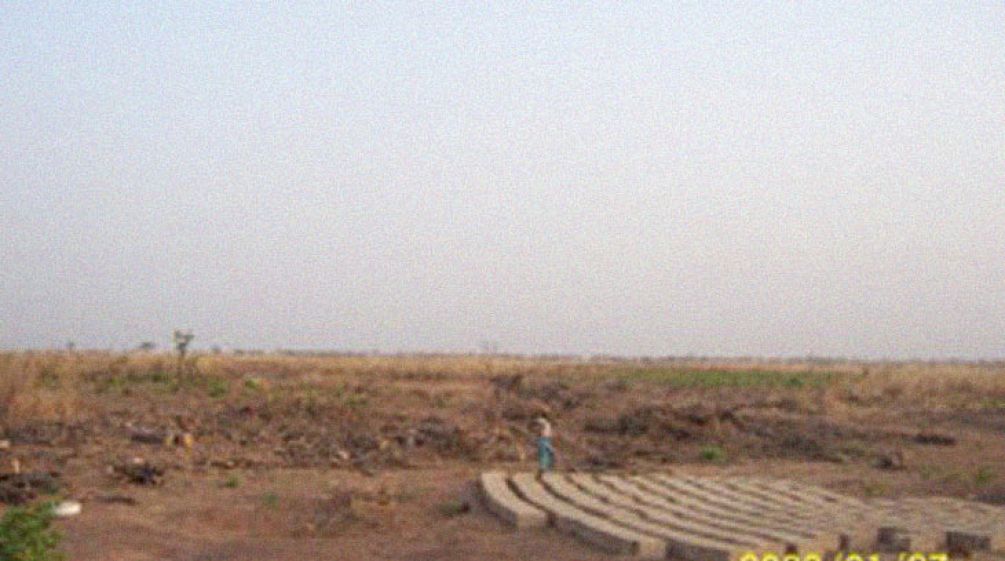 Photo: WRM
Photo: WRM
Dec 18, 2008
This is the story of how a Norwegian biofuel company took advantage of Africa’s traditional system of communal land ownership and current climate and economic pressure to claim and deforest large tracts of land in Kusawgu, Northern Ghana with the intention of creating “the largest jatropha plantation in the world”.
By Bakari Nyari, Vice Chairman of Regional Advisory and Information Network Systems (RAINS), Ghana and African Biodiversity Network Steering Committee member
Jatropha curcas, is indigenous to Central America. Its oily seeds can be used to produce biodiesel. As it can be cultivated in poor soil it is seen as an ideal plant for biofuel production. The plant, particularly the seeds, is toxic to humans and animals. Bypassing official development authorization and using methods that hark back to the darkest days of colonialism, this investor claimed legal ownership of these lands by deceiving an illiterate chief to sign away 38 000 hectares with his thumb print. This is also the story of how the effected community came to realize that, while the promised jobs and incomes were unlikely to materialize, the plantation would mean extensive deforestation and the loss of incomes from gathering forest products, such as sheanuts. When given all the information the community successfully fought to send the investors packing but not before 2 600 hectares of land had been deforested. Many have now lost their incomes from the forest and face a bleak future. Those of us involved in this struggle want to tell the story as a warning to other African communities, leaders and policy-makers to be wary of the promises made by biofuel investors and the disasters that their land grabbing may bring.
Background to rural livelihood in Northern Ghana
Rural livelihood in Northern Ghana is tenuous. Agriculture accounts for more than 90% of household incomes and employs more that 70% of the population in the region. Most of the agricultural production is by small-holders at subsistence level, reliant on seasonal rainfall which is unpredictable and sporadic. During the dry season from November to May very limited farming activities take place and much of the population is idle forcing people to migrate to the more prosperous southern parts of the country where they are employed in menial jobs. The onset of climate change, insufficient rainfall and occasional uncontrollable floods results in frequent crop failures which are having a serious impact on the livelihood for the majority of the population in Northern Ghana. Per capita income in this essentially subsistence agricultural economy continues to dwindle yearly, leaving the average farm family with no option but to face a six-month hungry period or migration either on a temporary or permanent basis. With limited formal sector employment and very few private companies, the bulk of the population of the northern sector have no alternative sources of income, apart from their meager farm produce. Literacy rates are also low: Approximately 65% of adults not having had any formal education. These are the circumstances that make Northern Ghana vulnerable to large-scale biofuel plantation development by outside investors in their search of land to produce alternative energy sources.
Unauthorized biofuel development in Kusawgu, Northern Ghana
In November 2007 a team from RAINS discovered massive destruction of vegetation cover over a large stretch of land near a village called Alipe within the White Volta River basin about 30 kilometres from Tamale, the capital town of the Northern region of Ghana. Heavy agricultural machinery were systematically pulling down trees and decimating the area a few metres south of the village. The land had been stripped bare of all its vegetation cover. Enquiry revealed that the site was to be the beginning of a large jatropha plantation developed by a Norwegian biofuel company called BioFuel Africa – a subsidiary of Bio Fuel Norway. At a public engagement session in Kusawgu, the traditional capital of the Kusawgu Division of the Gonja Traditional Council, Mr. Finn Byberg, Director of Land Acquisition for BioFuel Africa, stated that BioFuel Africa hoped to “develop the largest jatropha plantation in the world in Ghana”. The discovery of the cleared land brought the realization that the battle against land grabbing and community disempowerment was no longer just happening in other countries but also in Ghana. In collaboration with the Central Gonja District Assembly and the Environmental Protection Agency, work was suspended on the development site.
Rural communities who are desperate for incomes are enticed by developers who promise them a “better future” under the guise of jobs with the argument that they are currently only just surviving from the “unproductive land” and that they stand to earn a regular income if they give up the land for development. This argument fails to appreciate the African view of the meaning of the land to the community. While the initial temptation to give up the land to earn a wage is great, it portends of an ominous future where the community’s sovereignty, identity and their sense of community is lost because of the fragmentation that the community will suffer. The strategy for the acquisition of the land often takes the following course: The imaginations of a few influential leaders in the community are captured. They are told about prospects for the community due to the project and they were swayed with promises of positions in the company or with monetary inducements. The idea is that these people do the necessary “footwork” in the villages where they spread the word about job opportunities. A document is then prepared, essentially a contract, to lease the land to the company. In the event of problems the developer can press their claim by enforcing the ‘contract’ or agreement. When the legality of the process is not adequately scrutinized, the developers have their way but, subject to proper scrutiny, it emerges these contracts are not legally binding as they have not gone through the correct legal channels. This is what happened in this particular case in the Alipe area. RAINS immediately contacted the District Chief Executive (DCE), the political head of the District to inquire about the project. Neither he nor the District Assembly had any information about it. He had noticed the work on the site and was in the process of finding the “culprits” because they did not have any planning permission to undertake the development. To gain time, we advised the DCE to use the planning powers conferred on the District Assembly under the Local Government Act 1993 Act 462 to stop the destruction of the vegetation. Under this law nobody can undertake any development of land without seeking the prior approval of the District Assembly of the area. In this particular case the Assembly could not stop them owing perhaps to the highly politicized nature of the Assembly process and the vulnerability of the personnel there. Eventually, using the Environmental Assessment Regulations LI 1652, we managed to get them to stop the destruction but not before more than 2 600 hectares of land had been stripped of its natural vegetation cover.
Thumb prints and promises
Next we visited the Traditional ruler of the village to get information about any grants of the land he may have made to the proponents of the jatropha project. At this stage, the identity of the company responsible for the development had not yet been disclosed. They were described simply as “some white men”. In this community, like in most parts of Ghana, over 80 percent of the land is held under communal ownership and more that 70 percent of this land is managed by traditional ruler-chiefs mainly on behalf the members of the their traditional areas. The chief was very categorical that he had not made such a grant and that he had also been battling with those “white people” to stop them– without much success. He confirmed that he “thumb printed” a document in the company of the Assemblyman of the area which had been brought to his palace by the “white people” but he did not confirm its contents. The Chief was initially unwilling to go against the wishes of his people as his efforts to stop the developers were being interpreted by the community as driving away opportunities to earn an income during the current dry season”. Due to devastating effects of floods at the end of the rainy season, harvests had been very small. RAINS then visited the surrounding villages to gather first hand information about what the communities had been told about the project and how they felt about it. Interactions with the people revealed the same initial picture that the chief had given when we contacted him – there was so much euphoria about potential jobs that they did not counter the destruction of their communal lands and livelihood. Fortunately there were a number of skeptics who were convinced that ”all that glitters is not necessarily gold” and that the way in which their land was being destroyed did not portend of good things. The facts began to emerge – a big fish in Government was promoting the project and had deployed his business associates in the Region to front for him. This front man was immediately employed as the Local Manager of BioFuel Africa. The EPA then insisted that they must go through the processes of having an Environmental Impact Assessment made. We then had a public consultative forum in the community where we had a face-to–face confrontation Mr. Finn Byberg, Director of Land Acquisition for BioFuel Africa in the village square in front of the Chief’s palace. The audience and judges were the village communities affected by the proposed project.
Exposing the hoax
We met again a few days later on 28th January 2008 in the chief’s palace to discuss other issues pertaining to the acquisition of land. After the presentation by myself on behalf of RAINS and the discussion which followed, it became clear to all present that BioFuel Africa’s promises were really a hoax. With the level of community engagements that we made in the villages, it was obvious to the local communities that the development would cause more danger to the survival of the community than any benefits that would arise from it. The communities understood the impact that such a project would have on their lives individually and on the community in general. But how long will this hold as they sit idle for the rest of the year until the rains come in April? There was conviction that the promises of jobs and a new improved life would not materialize because Mr Finn Byberg, the Chairman of BioFuel Africa confessed, during his presentation that he could not state categorically what commitments the company would make He said, “Commitments are not very easy and so when I am required to make these, I need to be very careful. I do not want to be caught for not keeping my word.”. This was incorporated in the argument that his company was still learning. This made it clear that our land is being used for experimentation. Mr Byberg’s promise of jobs, shared prosperity and improved livelihoods – the Company’s main benefit to the community – were not really commitments for which the community could hold him to, but were mere campaign gimmicks. Most vocal indeed were the women at the session. Looking Mr Finn Byberg in the face a women asked, “Look at all the sheanut trees you have cut down already and considering the fact that the nuts that I collect in a year give me cloth for the year and also a little capital. I can invest my petty income in the form of a ram and sometimes in a good year, I can buy a cow. Now you have destroyed the trees and you are promising me something you do not want to commit yourself to. Where then do you want me to go? What do you want me to do?” The response from Mr Byberg was to express regret and a promise not to repeat it. This was the tone in which the session ended. The next Monday we assembled again before the Chief at the request of the biofuel company. Here another battle began – the battle as to whether a contract existed between the Chief and Biofuel Africa for 38 000 hectares of land in four locations in the traditional area. Here, due to the circumstances prior to the thumb printing of the document and the subsequent events which shrouded the documentation process in mystery, we eventually won a lengthy legal battle.
The ongoing threat of biofuels
But the questions we are asking ourselves hinge on whether we can ultimately win this battle. I am confident we can because the truth is our guide and the interest of the community is our goal. We cannot afford to fail otherwise there will be chaos. But the war is heating up. I have started hearing about large tracts of land being acquired in various parts of the Northern Region. This is the most expansive region with the lowest population density and is thus ideal for land grabbers. Another obstacle is the government policy to have 10% of the total fuel content in Ghana by 2015 consist of biofuel - a rather over-ambitious proposition. We need a more aggressive campaign to halt land grabbing. We need to engage with traditional rulers, District Assemblies and Politicians about this ominous phenomenon. We need visibility through print and electronic media to put our message across effectively to a wider audience. RAINS has a strategy to build on the rapport that it has developed through the OSIWA project with traditional rulers to open up another channel for engagement. We cannot afford to be caught unawares in this war with the biofuel companies. The ancestors are on our side and we shall win the war!
LESSON NO. 1 The devastating effects of climate change on the already poor rural communities renders local communities vulnerable to all sorts of situations thus making them easily amenable to all sorts of utopian promises.
LESSON NO. 2 The developers have the tendency to raise the hopes and temporarily win the support of local communities by enticing the villagers with the promise of jobs and income.
LESSON NO. 3 We cannot rely wholly on the District Assemblies to support us in this battle because of their vulnerability to political manipulation. A DCE who cannot convince his staff to accept a project of this nature could be readily dismissed from his job.
LESSON NO. 4 Documents should not be signed until the contents and the implications of the agreement are fully understood. As the Kusawgu Chief said, “they will use it to tie your hands” literally meaning you will be bound by the contents of the contract.
LESSON NO. 5 The strategy employed by the biofuel companies also appears to be to create conflict in communities by making community leaders appear anti-development which thus sets the people against them.
LESSON NO. 6 When interacting with communities it is important not to appear to oppose the project but go through an analysis of it with the people they can understand for themselves the full impact the development will have on their lives and livelihoods.
Source: http://www.wrm.org.uy/subjects/agrofuels/Biofuel_Northern_Ghana.pdf
